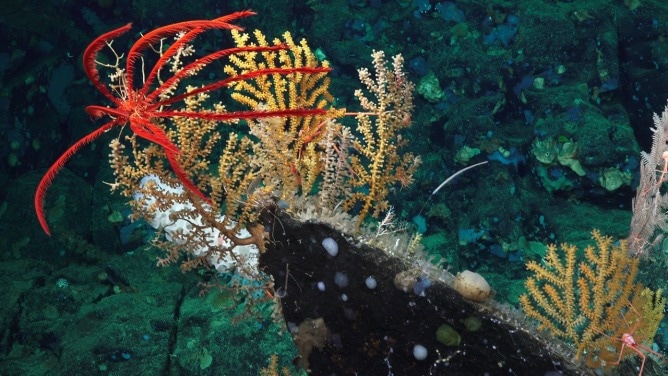The deep sea is one of the least mapped areas in the world. It comprises numerous vulnerable ecosystems that play key roles in the carbon cycle. However, the deep sea is directly affected by human-caused climate change and might face additional challenges because of the efforts that artificially mitigate climate change.
 Diverse marine life (crinoid, octocorals, and sponges) on a seamount off the Pacific coast of Costa Rica. Image Credit: Schmidt Ocean Institute, FK190106, Erik Cordes Chief Scientist.
Diverse marine life (crinoid, octocorals, and sponges) on a seamount off the Pacific coast of Costa Rica. Image Credit: Schmidt Ocean Institute, FK190106, Erik Cordes Chief Scientist.
These efforts have resulted in geoengineering solutions capable of operating on massive spatial scales.
Ocean-based climate interventions (OBCIs) are largely being acclaimed as a potential solution to climate change mitigation. These interventions employ various technologies to eliminate CO2 from the atmosphere and sequester it in the deep sea, manage solar radiation, or generate renewable energy.
However, little is known about the impact of OBCI technologies on ocean biogeochemistry and biodiversity. This is especially true for deep-sea ecosystems, which cover more than 40% of the Earth’s surface and encompass extremely vulnerable species and ecosystems.
To contemplate the deep-sea impacts of OBCI, an international group of experts joined remotely as part of the Deep Ocean Stewardship Initiative’s Climate Working Group.
A research group headed by Dr. Lisa Levin from UC San Diego’s Scripps Institution of Oceanography and Dr. Moriaki Yasuhara from The University of Hong Kong’s School of Biological Sciences and The Swire Institute of Marine Science examined the proposed approaches to evaluate their possible effects on deep-sea ecosystems and biodiversity.
Their observations, published in the journal Science, raise a significant concern about the potential effects of these technologies on deep-sea ecosystems and request for an integrated research effort to carefully assess the benefits and costs of each intervention.
The study’s results highlight the potential effects of OBCIs on deep-sea ecosystems. Numerous pieces of evidence directed experts to express deep concern and call for an interconnected research framework to carefully evaluate deep-sea impacts in mitigation planning.
Balancing Hope and Risk
While the increased interest in OBCIs as potential tools for mitigating impacts may offer some hope for a more sustainable future, the potential environmental impacts and efficiency at scale have not been adequately evaluated. Furthermore, governance of OBCI activities is in its infancy, posing risks to deep-sea biodiversity and ecosystems.
Direct CO2 injection into the deep sea, for instance, can sequester large amounts of carbon dioxide from the atmosphere and lower the overall concentration of greenhouse gases. Even though direct CO2 injection holds promise as a climate intervention, it is extremely risky.
One possible consequence is the occurrence of hypercapnia—a condition that happens when the concentration of carbon dioxide in the water outpaces specific thresholds—which can be harmful to marine life and ecosystems.
Other carbon sequestration technologies, like ocean fertilization (increasing phytoplankton production in the surface ocean and resulting in their deposition on the deep ocean floor) and crop waste deposition (deep-sea disposal of terrestrial crop waste), could also alter the food and oxygen availability for deep-sea life.
Because of the impact of industrial fisheries, pollution, warming, deoxygenation, acidification, and other climate-change-related issues, the deep sea is facing unprecedented threats. OBCIs could add to the pressure and endanger the operation of these critical systems for the entire planet.
I see open ocean-based climate intervention as a rapidly emerging arena that poses significant challenges for deep-ocean ecosystems, and thus demands new science and governance before we commit to action.
Lisa Levin, Study Lead Author, Scripps Institution of Oceanography
“Especially given the vastness, vulnerability, comparatively pristine nature, and poor scientific understanding of the deep-sea ecosystem, we should be careful to green-light these activities that could have irreversible impacts,” Moriaki Yasuhara added.
More studies are needed to determine the impact of the interventions on the marine environment, which may be irreversible. Before implementing geo-engineered solutions on a large scale, researchers must first comprehend what those pressures will be and, as a result, what the deep sea may look like in the future.
Journal Reference:
Levin, L. A., et al. (2023) Deep-sea impacts of climate interventions. Science. doi.org/10.1126/science.ade7521.